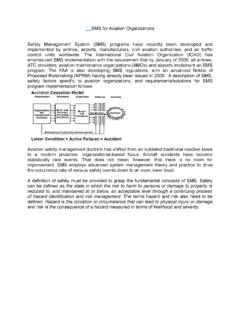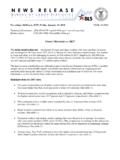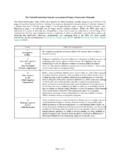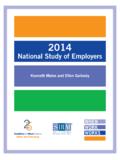Transcription of a non-pathologic state resulting in a decreased …
1 Human Fatigue in Aviation Operations Basics of Fatigue Fatigue is defined as a non-pathologic state resulting in a decreased ability to maintain function or workload due to mental or physical stress. Fatigue, by itself, is not the danger. The threat to safe aviation operations arises from the impairment to alertness and degradation of performance. Today's global aviation system demands a constant 24-hour operational structure. Pilots, cabin crew, maintenance personnel, and ATC staff must work in conjunction with this around-the-clock schedule. This requirement introduces stressful physiological challenges. These challenges affect productivity, performance, and safety. By acknowledging these challenges, an aviation organization can promote safe and efficient operations. If organizational procedures and policies ignore these challenges, the potential for costly incidents and accidents becomes very real.
2 Humans have an inherent biological need for sleep. We are genetically programmed with a circadian pacemaker that promotes us to sleep at night and be awake during the day on a 24-hour schedule. Around-the-clock operations pose a challenge to these basic physiological principles. Such operational concerns as shiftwork, changing work schedules, multiple time zone transitions, extended periods of wakefulness, and sleep loss can cause sleep and circadian disruptions that greatly enhance the opportunity for an incident or accident. The resulting degradation in performance can erode the critical safety margin in aviation operational systems. Research has found that sleep is a complex and active physiological state . When deprived of sleep, the brain generates the response of sleepiness. This signal prompts the individual to obtain sleep, as the physiological need has not been met.
3 If deprived of sleep for long enough, the brain can spontaneously shift from wakefulness to sleep, in an uncontrolled fashion. The more fatigued the person is, the more rapid and frequent the intrusions into wakefulness these sleep episodes will be. These intrusions can be very short ( microsleeps, lasting only seconds) in duration, or they may be as long as several minutes. Spontaneous sleep episodes severely degrade performance, perhaps even at critical times (approach and landing after an extended flight segment, ATC surge at a busy airport, aircraft maintenance during night shift, etc.). Performance degradation induced by fatigue results in negative effects to vigilance, reaction time, memory recall, psychomotor coordination skills, information processing capabilities, and decision-making skills. As fatigue levels increase, even despite increased effort, poorer performance is still demonstrated.
4 If fatigue is not countered, uncontrolled sleep episodes may be experienced by affected workers. These events can result in the total loss of capability to perform. Some recent sleep research has related performance degradation by equating it to Blood Alcohol Concentration (BAC). After 17 hours of sustained wakefulness, cognitive performance decreases to a level equivalent to the performance impairment observed at a blood alcohol concentration of This is the proscribed level of alcohol intoxication in many western industrialized countries. After 24 hours of sustained wakefulness, cognitive performance decreases to a level equivalent to the performance deficit observed at a blood alcohol concentration of roughly FAA. regulations prohibit operation of an aircraft with a BAC of or higher. This viewpoint clearly illustrates the severe hazards associated with fatigued personnel conducting operations.
5 We are a nation of sleep deprived workers. Estimates suggest that many adult Americans are getting from to hours less sleep per night than needed. Weekly sleep debt accumulations of to hours are therefore possible. We attempt to recover from this sleep debt by sleeping in on weekends or other off-duty days. Here again, recent research indicates that countering this sleep deficit is not as easy as simply extending our sleep periods. After attempted sleep deficit replenishment, the body's circadian rhythm allows sustained performance until just after the period between 3 and 5 Past that time frame, the level of performance severely degrades. Cancellation of a sleep debt requires obtaining a deeper sleep for one to two nights along with an increase in sleep duration. Fatigue and Aviation Accidents Human fatigue has been indicated as a causal factor in some significant aircraft accidents.
6 It has been estimated that fatigue contributes to 20-30% of transport accidents. In commercial aviation operations, about 70% of fatal accidents are related to human error, therefore the risk of crew fatigue contributes to about 15-20% of the overall accident rate. The following list notes some aircraft accidents that were found to involve fatigue: 1993 Kalitta International, DC-8-61F at Guantanamo Bay, Cuba 1997 Korean Air, 747-300 at Guam 1999 American Airlines, MD-82 at Little Rock, AR. 2004 MK Airlines, 747-200F at Halifax, Nova Scotia 2004 Corporate Airlines, BAE Jetstream31 at Kirksville, USA. 2004 Med Air, Learjet35A at San Bernadino, CA. 2005 Loganair, B-N Islander at Machrihanish, UK. 2006, 27th Aug, Comair, CRJ100 at Lexington, KY. 2007, 25th June, Cathay Pacific 747F at Stockholm, Sweden 2007, 28th Oct, JetX, 737-800TF-JXF Keflavik airport, Iceland The 1993 crash of a Kalitta International DC-8-61F at Guantanamo Bay, Cuba in 1993 is generally accepted as the first accident in history for which pilot fatigue was cited as one of the primary causes.
7 The pilot stalled a perfectly serviceable aircraft into the ground on approach. His inability to monitor the aircraft's safe flight was found to be as the direct result of fatigue. The NTSB stated the following as the primary cause for the crash: The impaired judgment, decision-making, and flying abilities of the captain and flight crew due to the effects of fatigue; the captain's failure to properly assess the conditions for landing and maintaining vigilant situational awareness of the airplane while maneuvering onto final approach; his failure to prevent the loss of airspeed and avoid a stall while in the steep bank turn; and his failure to execute immediate action to recover from the stall. The crew had been on duty for 18 hours, flown for nine hours, and was suffering from circadian rhythm desynchronization.
8 In 1999, an American Airlines MD-82 crashed at Little Rock, Arkansas. The aircraft landed on runway 4R near midnight in a thunderstorm. The crew's misjudgments started with their hope that, after nearly 13 and one-half hours on duty, they would not have to divert because of bad weather. It was near midnight at the end of a long day, with a storm front passing through the area. ATC had advised the crew of significant wind direction/velocity changes. Just before landing the captain stated This is a can of worms . After touchdown, the aircraft overran the runway and broke up, resulting in the deaths of the captain and ten passengers. These events are just two of the many aircraft accidents in which investigators determined fatigue to be causal. Fatigue Management and Countermeasures Management of fatigue requires an integrated program that addresses the requirements of all involved in an operational environment.
9 Management commitment, education and training, and program implementation/management constitute some of the components of a successful fatigue management program. As with any safety management program, the initiative to address fatigue must have unwavering and visible support from the highest levels of management. Sufficient resource allocation must be dedicated to ensure the success of a program. Senior executives need to be involved with the formulation and management of their organization's fatigue program. Education and training provide the knowledge to support and enable an effective program at all levels of the organization. The education for all personnel levels must encompass fatigue basics, clear recommendations for countermeasures, and provide industry-specific information. All personnel need to understand how their function in the organization interfaces with the countermeasures program.
10 Fatigue management programs require periodic evaluation and refinement. Program effectiveness metrics should be analyzed to gauge how well the program is working. The results from these evaluations should then be used to refine the program and even further enhance effectiveness. Fatigue countermeasures can be thought of as consisting of mainly two broad strategies: prevention and mitigation. Prevention seeks to minimize or eliminate fatigue through effective measures such as basic sleep health awareness, good sleep hygiene, and sufficient sleep quality and quantity. Mitigation attempts to combat fatigue more in the actual operational environment and therefore provides measures to deal with the onset of fatigue while working. Environmental lighting, controlled napping, and caffeine use are examples of fatigue mitigation strategies.








